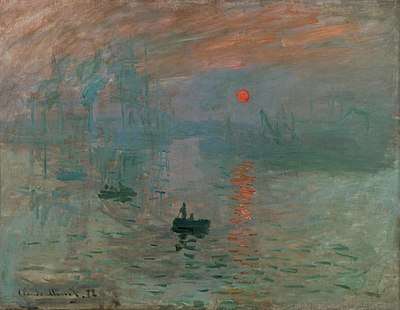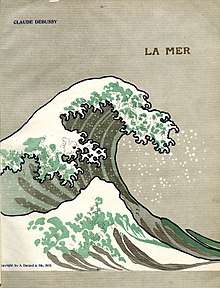Impressionism in music
Impressionism in music was a movement among various composers in Western classical music (mainly during the late 19th and early 20th centuries) whose music focuses on mood and atmosphere, "conveying the moods and emotions aroused by the subject rather than a detailed tone‐picture".[1] "Impressionism" is a philosophical and aesthetic term borrowed from late 19th-century French painting after Monet's Impression, Sunrise. Composers were labeled impressionists by analogy to the impressionist painters who use starkly contrasting colors, effect of light on an object, blurry foreground and background, flattening perspective, etc. to make the observer focus his attention on the overall impression.[2]
| Periods, eras, and movements of Western classical music | ||||||||||||||||||||
|---|---|---|---|---|---|---|---|---|---|---|---|---|---|---|---|---|---|---|---|---|
| Early period | ||||||||||||||||||||
|
||||||||||||||||||||
| Common practice period | ||||||||||||||||||||
|
||||||||||||||||||||
| Late 19th-century to 20th- and 21st-centuries | ||||||||||||||||||||
|
||||||||||||||||||||
The most prominent feature in musical impressionism is the use of "color", or in musical terms, timbre, which can be achieved through orchestration, harmonic usage, texture, etc.[3] Other elements of music impressionism also involve new chord combinations, ambiguous tonality, extended harmonies, use of modes and exotic scales, parallel motion, extra-musicality, and evocative titles such as Reflets dans l'eau (Reflections on the water, 1905), Brouillards (Mists, 1913) etc.[2]
History
Claude Debussy and Maurice Ravel are two leading figures in impressionism, though Debussy rejected this label (in a 1908 letter he wrote "imbeciles call [what I am trying to write in Images] 'impressionism', a term employed with the utmost inaccuracy, especially by art critics who use it as a label to stick on Turner, the finest creator of mystery in the whole of art!") and Ravel displayed discomfort with it, at one point claiming that it could not be adequately applied to music at all.[4][5] Debussy's impressionist works typically "evoke a mood, feeling, atmosphere, or scene" by creating musical images through characteristic motifs, harmony, exotic scales (e.g., whole-tone and pentatonic scales), instrumental timbre, large unresolved chords (e.g., 9ths, 11ths, 13ths), parallel motion, ambiguous tonality, extreme chromaticism, heavy use of the piano pedals, and other elements.[2] Some impressionist composers, Debussy and Ravel in particular, are also labeled as symbolist composers. One trait shared with both aesthetic trends is "a sense of detached observation: rather than expressing deeply felt emotion or telling a story"; as in symbolist poetry, the normal syntax is usually disrupted and individual images that carry the work's meaning are evoked.[2]
While impressionism only began as a movement after about 1890, Ernest Fanelli was credited with inventing the style in the early 1880s. However, his works were unperformed before 1912. The performance of his works in that year led to claims that he was the father of musical Impressionism. Ravel wrote, "this impressionism is certainly very different from that of present-day composers...Mr. Fanelli's impressionism derives more directly from Berlioz." He added that Fanelli's alleged priority does not in any way diminish the achievements of later composers: "the investigations of the young Fanelli could not have diminished those of his colleagues...It is peculiar that these investigations suddenly assume importance because their embryo is discovered in a work written 30 years ago."[6]
Other composers linked to impressionism include Lili Boulanger,[7][8] Isaac Albéniz,[9] Frederick Delius,[10] Paul Dukas,[9] Alexander Scriabin,[11] Manuel de Falla,[9] John Alden Carpenter,[9] Ottorino Respighi, Charles Tomlinson Griffes, and Federico Mompou.[9] The Finnish composer Jean Sibelius is also associated with impressionism,[10] and his tone poem The Swan of Tuonela (1893) predates Debussy's Prélude à l'après-midi d'un faune (regarded as a seminal work of musical impressionism) by a year.[10] The American composer Howard Hanson also borrowed from both Sibelius and impressionism generally in works such as his Second Symphony.[10]
Characteristics
One of the most important tools of musical Impressionism was the tensionless harmony. The dissonance of chords were not resolved, but were used as timbres. These chords were often shifted parallel. In the melodic field the whole tone scale, the pentatonic and church tonal turns were used. The melodics were characterized by their circular melodic movements. The timbre became the stylistic device of Impressionism instead of concise themes or other traditional forms.[12]
See also
References
- Michael Kennedy, "Impressionism", The Oxford Dictionary of Music, second edition, revised, Joyce Bourne, associate editor (Oxford and New York: Oxford University Press, 2006). ISBN 9780198614593.
- J. Peter Burkholder, Donald Jay Grout and Claude V. Palisca, A History of Western Music, eighth edition (New York: W. W. Norton & Company, 2010). ISBN 9780393932805.
- Nolan Gasser, "Impressionism". Classical Archives. Accessed 9 November 2011.
- Maurice Ravel, A Ravel Reader: Correspondence, Articles, Interviews, compiled and edited by Arbie Orenstein (New York: Columbia University Press, 1990): p. 421. ISBN 9780231049627. Unaltered paperback reprint (Mineola, New York: Dover Publications, 2003), ISBN 9780486430782.
- François Lesure and Roger Nichols, Debussy Letters (Harvard University Press, 1987): p. 188. ISBN 9780674194298
- Maurice Ravel, A Ravel Reader: Correspondence, Articles, Interviews, compiled and edited by Arbie Orenstein (New York: Columbia University Press, 1990): pp. 349–42. ISBN 9780231049627. Unaltered paperback reprint (Mineola, New York: Dover Publications, 2003), ISBN 9780486430782.
- By Sylvia Typaldos, Nocturne for violin (or flute) & piano
- By Sylvia Typaldos, Pie Jesu for mezzo-soprano, string quartet, harp & organ
- "Impressionism, in Music", The Columbia Encyclopedia, sixth edition (New York: Columbia University Press, 2007) (Archive copy from 3 April 2009, accessed 25 December 2012).
- Richard Trombley, "Impressionism in Music", Encyclopedia of Music in the 20th Century, edited by Lol Henderson and Lee Stacey (London and Chicago: Fitzroy Dearborn, 1999). ISBN 9781579580797; ISBN 9781135929466.
- Christopher Palmer, Impressionism in Music (London: Hutchinson; New York: Charles Scribner's Sons, 1973): 208.
- "Musikalischer Impressionismus in Musik | Schülerlexikon | Lernhelfer". www.lernhelfer.de (in German). Retrieved 2020-06-12.
Further reading
- Fulcher, Jane. Debussy and His World. Princeton: Princeton University Press, 2001. ISBN 978-0691090429.
- Machlis, Joseph, and Kristine Forney. The Enjoyment of Music, seventh edition. New York: W. W. Norton & Company, 1995. ISBN 0-393-96643-7.
- Pasler, Jann. "Impressionism". The New Grove Dictionary of Music and Musicians, second edition, edited by Stanley Sadie and John Tyrrell. London: Macmillan Publishers, 2001.
- Thompson, Oscar. Debussy, Man and Artist. New York: Dodd, Mead & company, 1937.

